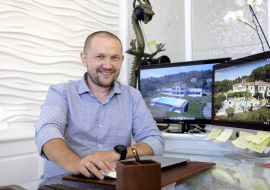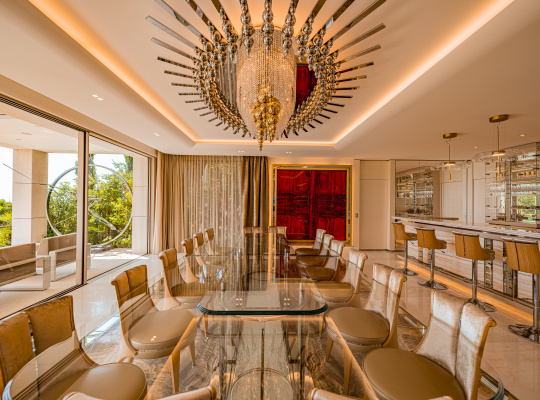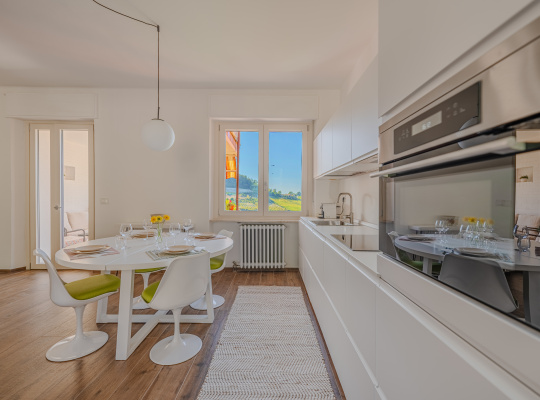
Luxury, historic and rare property in Italy | Villa Sultana in Ospedaletti | First Casino in Italy

Villa Sultan! Among the most luxurious real estate in Italy and the world, Villa Sultana in Ospedaletti stands out with special chic - a monumental building with three domes, which once housed the first casino in Italy. Today, this prestigious, luxurious luxury villa is considered a historical monument of the country's culture and the main attraction that tourists tend to see when they decide to visit the famous resort town of Ospedaletti.

Today it is hard to believe that in the distant 1860 the commune of Ospedaletti was just a village consisting of a handful of houses, but already in 1871 this sleepy fishing village woke up from its sleep. Was she woken up by the state rail company Societ? Anonima Ferrovia Alta Italia (SFAI), which, together with the government of the country, started the implementation of a grandiose railway construction project. Things were going well, and in 1974 the Ospedaletti railway station even acquired its own post office with a telegraph.
The turning point in the history of Ospedaletti was August 30, 1880. It was on this day that the French company Lyonnaise Soci?t? Fonci?re decided to develop a small railway station and turn it into a real paradise for wealthy tourists. The impetus for this decision was that the management of the company - one of the leading real estate companies in France - visited Ospedaletti and was so fascinated by this place that they decided to urgently create everything necessary for recreation at any time of the year. The very next month, French investors acquired ownership of most of the land that belonged to the commune. Following this, the construction of twelve new spacious streets was launched, the total length of which was 9430 meters. In parallel, expensive real estate is being built - elegant and even majestic buildings: the villas Auster, Belvedere, Clotilde, Ducha, La Tour, Christie, Cirio, Rosalia. Investors did not forget about luxury hotels to accommodate wealthy guests, building Royal, Riviera, Metropol and Suiss hotels one after another. And finally, in 1883, the hotel "Queen Margarita" was built on the first coastline, and on Corso Regina Margherita street, the pearl of Ospedeletti - the luxurious villa "Sultana".

French investors also took care of building a road for omnibuses - large carriages drawn by one horse. On this road, connecting Ospedaletti with the famous resort town of San Remo, everyone could travel, and not just individual representatives of the nobility, which became another of its indisputable advantages. Let us add that it was in those years, during the years of large-scale construction and bright hopes, that the emergence of sectors of the economy began, which to a large extent determined the future of the commune. First of all, we are talking about tourism, which developed at a rapid pace thanks to fashionable hotels and a wonderful climate. In addition, the inhabitants of the former fishing village began to grow flowers very actively (primarily carnations), and the intensive development of floriculture began a few years after the first flower market in the country was created on the Station Square in Ospedaletti.

What about Villa Sultana? This remarkable monument of history and architecture is worth telling in more detail. And it is worth starting the story with a description of the building, which, when it was an elite entertainment club, like a magnet, attracted rich tourists from all over the world to its halls. Villa Sultana is located on a hill in the center of Ospedaletti, about 250 meters from the sea. The building is surrounded by a lush park with palm trees and tall trees, spread over a plot of 14,000 square meters, as well as an unusual-looking botanical garden. Work on the construction of the villa began in 1883 and lasted exactly one year. The authorship of this masterpiece belongs to a native of Nice, architect S.M. Biacini (1841-1913), assisted by Lord Jocelin of Menton and Mr. Bonfante of San Remo. The decorator was Mr. Morgari, inspector of the Museum of Fine Arts in Turin, while Messrs. Meroni, Fosati, Pavesi and Crespi were responsible for decorating the rest of the villa. Finally, the laurels of the organizer of the work on this project belong to Mr. Marmaglia from Turin. The most famous researcher of French Renaissance art, Garnier (1825-1898), wrote that the architect Biacini, working on the project of the Sultana Villa, took as a basis the sketches of the casino in Monte Carlo, built according to his own project between 1878 and 1979.

One way or another, but compared to other buildings in Liguria, Villa Sultana stands out for its unique architecture. In her appearance, the features of eclecticism of French origin, typical of the French Renaissance, immediately catch the eye. Like other buildings made in this style, all the exquisite luxury of the Villa "Sultana" is directly related to the use of architectural elements of the Italian Renaissance, similar in spirit to the great era of Michelangelo and da Vinci. Let's take a short mental walk around the Sultana Villa, which will allow us to better imagine the external appearance and internal arrangement of this magnificent building. Starting from the Queen Margarita Hotel, we will walk along the paths of the park and go straight to the elegant central staircase. Climbing the marble steps, we will find ourselves in the atrium - a huge hall, which can rightfully be called the heart of the whole building. The extraordinary impression that the atrium of the Sultana Villa leaves is largely due to its grandiose size (the area of the hall is 100 square meters) and an unusual octagonal shape. Another curiosity of the atrium was a window located right in the roof at a height of 25 meters from the ground. Through this window, sunlight poured freely into the atrium, allowing you to freely enjoy the cloudless sky of Italy.

Unfortunately, the roof of the atrium, made in the form of an octagonal dome, collapsed in 1989, and today the former splendor can only be judged from the surviving photographs. From the atrium we can get into several rooms at once. This is a bar with an area of 35 square meters, a 60-meter service corridor and two side wings of the villa, each with an area of about 65 square meters. In turn, from each wing opens a path to a gallery with an area of about 180 square meters and a height of 9 meters. Passing to the southern part of the gallery, we will be able to admire a beautiful view of the porch. You can also walk along the main facade of the building, where the path also runs - it ends near two semicircular terraces located on the sides of the villa. Villa Sultana was conceived as a casino, which means that its center was a gambling room. Later, after some redevelopment, an entertainment club was opened here, in which the guests of the Riviera, brilliant aristocrats from Western and especially Eastern Europe, played and had fun, talked on a variety of topics and spent time serenely, littering with money. In addition, social events, conferences, symposiums, various ceremonies and musical evenings were organized here. Entertainment halls, friendly atmosphere, delicious cuisine and magnificent balls, as well as the opportunity to get to know the most sophisticated audience and establish business relations, attracted the best guests of the country here.




It is not without reason that the Sultana Villa is associated with the birth of the concept of a transfer, which was organized for even greater comfort of visitors. Immediately after arriving by train in Ospedalleti, noble tourists were met right at the station by wagons, and later by cars that delivered them to the famous place of fun. Soon, due to the diversity of the wealthy people who came here, it even became necessary to arrange prayer rooms for representatives of various religions and faiths. In the special rooms of the villa, each in its own room, the representation of the German Evangelical Church, where Pastor Hartmann preached, the representation of the Anglican Church and two non-Catholic chapels. In 1884, the year of its opening, Villa Sultana received a gambling license issued by the prefect of Sanremo, thus becoming the first casino in Italy.


Villa "Sultana" remained such until 1905, when the license was transferred to the casino of the city of San Remo, which is still operating today. Since then, the elegant villa has played the role of a private wealthy club, still hosting wealthy gentlemen. This continued until August 1914, when the outbreak of the World War put an end to the happy time that remained in history under the name of the Belle Epoque. At the beginning of the Second World War, the Sultana Villa, which had been closed for many years by that time, served as a home for military units until the end of the armed conflict and the victory of the USSR over Germany. Subsequently, the villa has undergone a slight refurbishment. Certain changes have affected the internal architecture, which made it possible to use this building as a private residence. The villa remained a private residence until the end of the 50s, when it suffered the same sad fate as many other monuments of the cultural heritage of Italy. The magnificent building, which was once a real Mecca for the color of the European aristocracy, gradually fell into disrepair and has not been restored to this day.




We offer investors, rich people who love Italy and its history, to buy this Lot. Negotiations take place exclusively in a private conversation. Projects and all related documents are ready for consideration.

Services

20/07/2024
Real estate auctions 2024

20/07/2024
Decree “Save your home 2024”

24/02/2023
Visa Residenza Elettiva

06/10/2022
Why do you need a residence permit in Italy.

06/10/2022
Buying a house on lease in Italy

06/10/2022